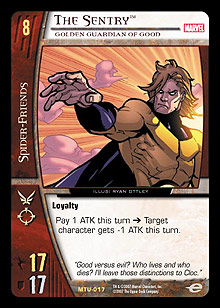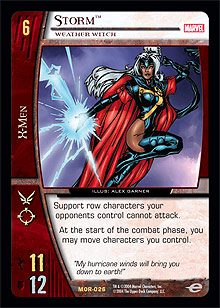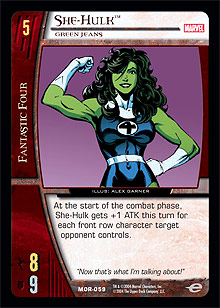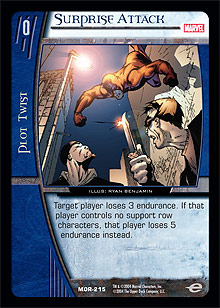
|
The Sentry™
Card# MTU-017


While his stats aren’t much bigger than those of the average 7-drop, Sentry’s “Pay ATK” power can drastically hinder an opponent’s attacking options in the late game.
Click here for more
|
|
|

|
|
|

 |
 |
|
|
| |
Learning how to construct a good Limited deck is just half the battle. While you may keep encountering similar scenarios in practicing with your favorite Constructed deck in any particular matchup, each Limited deck presents its own novel challenges during game play. Today I return to the realm of advice on playing your Limited deck, rather than constructing it. I’ve previously discussed choosing the initiative and mulliganing. These are strategic decisions that may affect how your game plays out many turns down the road. There are also many strategic decisions to be made in choosing which character(s) to play on a given turn and how long to hold onto your plot twists before unleashing them. At its core, however, Vs. System is a very tactical game. How you evaluate and orchestrate your attacks and formations each turn will often be the decisive factor in the outcome of your matches. What follows is a general overview of what thoughts should be going through your mind when making each of these decisions.
 Who? What? Recruit Who? What? Recruit
Whenever you have the initiative, you must make sure you are getting something accomplished with the turn. At the same time, it is still very important that you take long term strategy into account here. I cannot stress enough how important it is that you know the composition of your deck very well. You must know what character and non-character cards you have yet to draw in order to best utilize team-affiliated cards in hand or in play. You should also know how many characters in your deck fall into each team, at what costs they are, and how many of them have flight and/or range. If you have Thing: Heavy Hitter in your deck, you better be choosing to play FF characters over non-FF characters whenever you have the chance early in the game. If you have a lot more X-Men than Brotherhood characters, you will often want to play an X-Men character when you have the choice of one or the other, since you will be that much more likely to retain a strong unity among your characters for the purposes of reinforcing and team attacking.
If team considerations are roughly equivalent between two choices, there is a very good chance you should start playing characters with the highest total stats or with flight. If you opponent’s deck seems to be a tightly knit group in one team, you may be better off with a flyer to break up possible support row reinforcers, but if your opponent's team is more of a mixed bag, you may want to get the highest possible ATK value that you can on the board. There is also something to be said for range, especially if you have a good defensive character to hide behind.
Character names also come into play in these decisions. If you have only one 5-cost character in hand, and it shares a name with one of the two 3-cost characters you could play, you are usually better off playing the other 3-cost character. If you don’t draw a new 5-cost character, you will have to lose the other character. If, on the other hand, you also have two 5-cost characters, you probably do want to play the 3-drop with the same name since the chance to power-up the cheaper character may prove very helpful. Assuming your other 5-cost character is also good, you’ll be able to make use of both of your five cost characters (one in play and the other as a power-up) instead of maybe only having the chance to play one.
 If you’ve drawn a Dual Sidearms early, you might want to just get it on the board right away to have it take its toll on as many turns as possible. Then again, you might want to save it for a turn when you expect you’ll need it to keep the pressure on while you have the initiative or see that you’ll need it to make your opponent’s attack more costly. Having knowledge of how character stats break down at every cost can help out in this decision. For example, if you have Storm: Ororo Munroe and Borrowed Blade in your opening hand, you might want to hold onto the Blade until she enters play as it will help her get through Jean Grey: Marvel Girl or Invisible Woman: Sue Storm. If you’ve drawn a Dual Sidearms early, you might want to just get it on the board right away to have it take its toll on as many turns as possible. Then again, you might want to save it for a turn when you expect you’ll need it to keep the pressure on while you have the initiative or see that you’ll need it to make your opponent’s attack more costly. Having knowledge of how character stats break down at every cost can help out in this decision. For example, if you have Storm: Ororo Munroe and Borrowed Blade in your opening hand, you might want to hold onto the Blade until she enters play as it will help her get through Jean Grey: Marvel Girl or Invisible Woman: Sue Storm.
Being able to guess what your opponent may play is especially important if you have the initiative since you to get to see what is coming. If you’ve already played a game against this opponent, try to remember what they played last time on that turn. For example, in that last scenario with Storm if your opponent plays Blob after you’ve played out Storm with Borrowed Blade, things aren’t looking so hot. You will inevitably make some incorrect guesses, but it is important to make an educated guess as to what your opponent might play.
If you opponent has the initiative, it is worth your while to figure out what your opponent’s attacks should be with each character you would play and in each formation. Well, that is, if you want to be thorough and aren’t worried about your opponent falling asleep while you run through all the permutations. Otherwise the character you choose to play should be a good matchup with your opponent's. You want his or her largest character to be unable to deal with yours without assistance from a team attacker or from a plot twist. You are generally better off if his or her character cannot even force a mutual trade.
Where? Formation
 The default formation you use will generally be to have characters with range in the support row and those without in the front row. But the first time a card like Dazzler, Storm: Weather Witch, Sub-Mariner, Archangel, Juggernaut, Blastaar, or Banshee punishes you for putting your ranged character in the back row where he or she "belongs" you may start to second guess that decision. Since all of these cards are characters, you will at least get to see them before you do your formation if you don’t have the initiative so you can react accordingly. But what if you do have the initiative? Well, you have to access the likelihood of any of those cards entering play that turn and, if so, how badly you will suffer. When you have the initiative, it is much less likely that you will need to have a character hiding out in the support row, since you will hopefully be the one swinging and leaving your opponent's characters with few opportunities to get back at your ranged character anyway. So, if in doubt, I’d send everybody up into the front row when you have the initiative. The default formation you use will generally be to have characters with range in the support row and those without in the front row. But the first time a card like Dazzler, Storm: Weather Witch, Sub-Mariner, Archangel, Juggernaut, Blastaar, or Banshee punishes you for putting your ranged character in the back row where he or she "belongs" you may start to second guess that decision. Since all of these cards are characters, you will at least get to see them before you do your formation if you don’t have the initiative so you can react accordingly. But what if you do have the initiative? Well, you have to access the likelihood of any of those cards entering play that turn and, if so, how badly you will suffer. When you have the initiative, it is much less likely that you will need to have a character hiding out in the support row, since you will hopefully be the one swinging and leaving your opponent's characters with few opportunities to get back at your ranged character anyway. So, if in doubt, I’d send everybody up into the front row when you have the initiative.
Bear in mind that there are a few cards that punish you for being front row heavy. Surprise Attack, Quicksilver: Pietro Maximoff, and She-Hulk: Green Jeans are some examples.
 With the exception of a few cards that punish characters that hang out in certain locales, most of your considerations for your formation relate to an optimal series of attacks. As I’ve implied above, your formation is probably more important when you don’t have the initiative. You really want to be able to predict the attacks that are going to be made and come up with a plan that wrecks that series of attacks. Set up your formation in such a way that your opponent has an obvious best line of attack that will lead right into a trap. For example, you might leave Dragon Man up front vulnerable to an opposing Scarlet Witch if you have another Dragon Man in hand to power him up, since that power-up switches the situation from a scenario in which just your character is stunned to a scenario in which just the opposing character is stunned. There are plenty of ways your opponent can turn the tables back on you but you should always be looking for ways to lure him or her into making an attack that you are prepared for. With the exception of a few cards that punish characters that hang out in certain locales, most of your considerations for your formation relate to an optimal series of attacks. As I’ve implied above, your formation is probably more important when you don’t have the initiative. You really want to be able to predict the attacks that are going to be made and come up with a plan that wrecks that series of attacks. Set up your formation in such a way that your opponent has an obvious best line of attack that will lead right into a trap. For example, you might leave Dragon Man up front vulnerable to an opposing Scarlet Witch if you have another Dragon Man in hand to power him up, since that power-up switches the situation from a scenario in which just your character is stunned to a scenario in which just the opposing character is stunned. There are plenty of ways your opponent can turn the tables back on you but you should always be looking for ways to lure him or her into making an attack that you are prepared for.
Formations can also give hints as to what non-character cards may be lurking to wreck you in the future. Why did your opponent put Nightcrawler: Kurt Wagner and Shadowcat in the front row? Maybe he or she has a Danger Room, or maybe a Fastball Special.
When? Attack Sequence and Unleashing Plot Twists
On any given turn you should be trying to take down more than one character, cause the maximum possible breakthrough endurance loss, and minimize your opposition's ability to do the same.
The first attack you make should generally be taking care of one of two goals. You should be trying to take out reinforcement opportunities for your opponent or make sure your opponent’s largest character is taken down. Flying is very important in Vs., since you can swoop over and take out a possible reinforcer before you smash into the front row. This will maximize your breakthrough. Alternatively, if that character won’t be preventing much breakthrough anyway, you may be better served to smash immediately into your opponent's most fearsome character, if possible, so that you have a backup plan should your initial attack fail. If your remaining characters wouldn’t be able to take him or her down in a follow-up team attack, there isn’t much point.
 If you would only be pushing through a small amount of additional breakthrough with a given attack plan, it is often better just to make sure of your objectives rather than dealing that extra breakthrough. If you would be completely destroyed by an opponent’s countermeasure, such as a power-up, you may be better off playing it safe and sending in an additional team-attacker rather than holding it around to send in a few points of breakthrough uncontested if your attack does work. If you don’t blow your plot twists too early, you won’t need to be as cautious, since they can serve as your back-up plan. If you would only be pushing through a small amount of additional breakthrough with a given attack plan, it is often better just to make sure of your objectives rather than dealing that extra breakthrough. If you would be completely destroyed by an opponent’s countermeasure, such as a power-up, you may be better off playing it safe and sending in an additional team-attacker rather than holding it around to send in a few points of breakthrough uncontested if your attack does work. If you don’t blow your plot twists too early, you won’t need to be as cautious, since they can serve as your back-up plan.
With the exception of a few cards like Surprise Attack, you’ve hopefully come to realize that you don’t use your plot twists just because you can. I can’t really imagine a scenario where you want your Wild Sentinel delivering a Flying Kick on turn 1. You want your plot twists to get you through turns where you are in a bind. You want them to help you avoid having to KO a character or to force your opponent to KO a character. Even when these chances arise, it isn’t so simple. On turn 5, let’s say you can use a plot twist to force an opponent to have to stun and subsequently KO his or her 3-cost character. Do you really care that he or she has out a character with 4 ATK and 4 DEF on turn 6? You might be better off saving that plot twist for later. The answer will vary from game to game, though, and you will have to make that judgment in each case. At various stages in the game, you have to ask yourself whether you are playing for board control or for the endurance total race.
You need to pay attention to when the game is going to end. Don’t let your cards get stuck on the table. I’ve occasionally found myself sitting on a Flying Kick until later in the game only to lose a game with the endurance totals only 2 points in my opponent’s favor. I didn’t take into account that I wouldn’t get another attack in the game at all where the card would be useful, so it was still face-down at the end of the game. While you want to be saving your plot twists for times when you are changing the board position, you also don’t want to miss your last opportunity to wield them effectively.
Why? How?
Hmmm . . . well, hopefully I’ve covered that. If you have any further questions, send me an email at DHumpherys@metagame.com.
|
| |
| Top of Page |
|
 |
|
|
 |